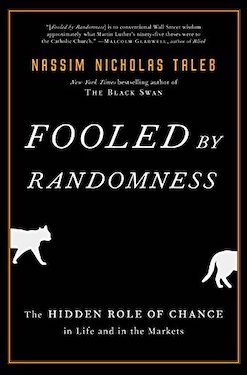 I listened to the audiobook. It really felt like I had already read the book because I’ve studied the topic extensively and seen other very similar content about the matter. Daniel Kahneman has also referred to Taleb’s work in his bestselling book that I reviewed some time ago. I was able to remind myself about all the shenanigans in trading. The book was originally published in 2001.
I listened to the audiobook. It really felt like I had already read the book because I’ve studied the topic extensively and seen other very similar content about the matter. Daniel Kahneman has also referred to Taleb’s work in his bestselling book that I reviewed some time ago. I was able to remind myself about all the shenanigans in trading. The book was originally published in 2001.
The future is unpredictable
The markets are random most of the time and I see why. There are thousands of participants trading in the market based on their own plans, emotions, goals etc. It makes the markets move. However, most retail investors think that if they have a view about the market or a particular stock, then everyone else should have the same view, therefore they are expecting price to move accordingly. That’s obviously wishful thinking, not reality. Sometimes it aligns well by pure luck and creates the false belief of being smart. Unexpected events will always happen in the future because people are not prepared for it, otherwise it wouldn’t happen. That’s why most of the time the market is not doing what everyone is expecting. It’s just the way demand and supply work. Covid is a good example of a black swan event. Nobody saw the sudden -35% market decline coming as well as nobody foresaw the sharp bull run that followed. Sure, many nailed it by their strategy, skill or luck, but overall it wasn’t obvious to happen. Things that have happened look more obvious in hindsight, but that’s just because they have already happened.
Risk management comes first
I didn’t actually know that Taleb has been a systematic options trader, at least that’s how I understood. He is fond of the Monte Carlo simulation with lots of examples in the book, something I’ve been using myself. The author emphasizes proper risk management a lot because it’s just so important to be able to play the game and not blow up. This all reminded me the importance of survival and staying in the game. He says rich traders are often bad traders cause they’ve taken reckless risk in a supportive cycle, look genius until the inevitable blow-up after the cycle ends. So many good examples from life. The book was written after the dot com bubble had burst and today we’re back at a phase of decline, where many investors have lost their fortunes in the bear market, sometimes even referred to as the dot com 2.0 with crypto and startups. We cannot know the future, but we can prepare for unexpected events.
Survivorship bias
We can see lucky traders because the losers are gone and aren’t visible. It is called survivorship bias. You can see it everywhere in the media and social channels. Of course, some people do have skill and strategies to trade, but good money is often made in short-term by pure luck and randomness. That’s why it could be misleading to follow someone with super performance and try to do the same. I’m much more comfortable doing my own thing that has statistical validity and get the outcome I get out of it, than try to go against randomness without the same luck behind my back as someone else might have had while taking reckless risk.
Past performance does not indicate future returns
Backtests show the past, not the future. Another reason why the hype around AI will probably make many sad, and poor in the market. Taleb was writing about backtesting and curve-fitting already 20 years ago. The way many beginning algorithmic traders start fitting indicators onto the past price data to find something that worked well historically, could be just noise and randomness without any statistical validity. His examples are eye-opening. I’m glad I’ve studied the topic enough to rest assured that I haven’t data mined my own strategies, which are based on some logic and edge.
Food for thought
An idea popped to my mind while writing this review. I checked that Apple stock (AAPL) has been trading in a price range of $124.17 – $176.15 during the past 12 months. That price range has 5198 different 1 cent prices. Thousands of variables during the past year that the market thought AAPL was worth at the time. We know that price moves represent different opinions of market participants (otherwise prices wouldn’t move), therefore following a single opinion or a headline of a particular stock would be like saying the right price of AAPL is exactly $156.31 and that’s the final truth. But hey, AAPL is currently trading at $168.41 at the time of writing this and we can’t argue about it. It’s the current market price. This is the truth. The price tells you the value of your account and your buying power. I follow price.
Conclusion
I think that newer traders, who still follow predictions and ten indicators on a chart to forecast the future while trying to be right, will have difficulty of really understanding Taleb’s point. One may understand the sentences, but it’s more about digging deep into the human psyche and biases we have, probabilities and chances in life as well as the role of luck. I recommend to read the book or listen to the audio version, but for newer traders I suggest doing it twice.
Fooled by Randomness by Nassim Nicholas Taleb book link
Share this post